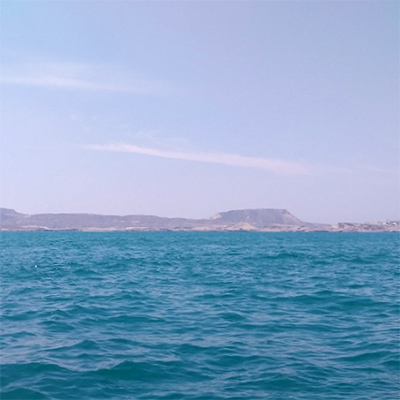Sites
Hengam Island
Emad Ezzatabadi
100 Views
Hengam Island sits in the middle of the Persian Gulf near the Strait of Hormuz. Because of its strategic and military importance, it played an important role during the Iran–Iraq War.
The island is oval-shaped and considered part of Qeshm County in Hormozgan Province.[1] It covers about 50 square kilometers and lies roughly two kilometers south of Qeshm Island. The highest point on the island is Mitra Peak, which rises 160 meters above sea level. Hengam has three villages, namely the Old Hengam in the south, New Hengam in the north, and Ghil in the west. The island has a humid climate, and most of its residents make their living by fishing and seafaring.[2] The name “Hengam” comes from two words: “Hen”, meaning “is”, and “Gam”, meaning “village”, referring to a settlement that once existed on the island.[3]
Due to its proximity to the Strait of Hormuz, the island has long played a crucial role in controlling maritime traffic in the Persian Gulf. Europeans even considered Hengam one of the two keys to dominance over the Persian Gulf. This strategic value led the British to establish their naval headquarters on Hengam Island in the Persian Gulf, using it to monitor and control the region’s vital shipping lanes.[4]
That situation lasted until 1928, when the Iranian Navy, under the order of Gholam-Ali Bayandor, liberated the island from British control.[5]
When Iraq invaded Iran in 1980, Hengam Island regained its strategic role. Along with Hormoz and Larak, it served as part of Iran’s defensive line and forward base against enemy attacks.[6] In 1983, the Baathist regime, looking to cripple Iran’s oil exports, received five Super Étendard fighter jets equipped with Exocet missiles from France. In response, Iran threatened to close the Strait of Hormuz. That October, Iran strengthened its military positions on Hengam and other nearby islands, conducting reconnaissance and support flights to prepare for a potential blockade. Subsequently, Sultan Qaboos of Oman warned the United States that Iran had the capability to close the Strait of Hormuz.[7] This, combined with the possibility of a direct military confrontation between Iran and the U.S. in the Persian Gulf, led the Islamic Revolutionary Guard Corps (IRGC) High Command to issue a directive titled “Defensive Measures for the Coasts and Islands of Iran in the Persian Gulf and the Sea of Oman” on December 12, 1983. Accordingly, the IRGC Region 9 Command, responsible for Fars and Bushehr provinces, was tasked with deploying a fully equipped company from the 19th Fajr Division (based in Fars Province) to Hengam Island, under the supervision of the Nouh (pbuh) Headquarters and the Central Command. The forces were also commissioned to provide the necessary air cover, artillery fire, and other defensive requirements.[8]
This directive did not apply only to Hengam but also included other key areas such as Qeshm, Bandar Abbas, Larak, and more. Although the Strait of Hormuz was never actually closed, Iran took the necessary steps to ensure deterrence and maintain the upper hand in the Persian Gulf. One of the most important measures in this regard—alongside the military build-up on Hengam and in the Persian Gulf—was acquiring Silkworm missiles. In 1984, Iran purchased 200 Chinese Silkworm anti-ship missiles and deployed part of them on the Hengam and Hormuz islands to target enemy ships if needed and maintain its naval dominance in the Persian Gulf.[9]
On July 3, 1988, at 10:25 AM, the U.S. cruiser USS Vincennes fired a missile at an Iranian Airbus passenger plane flying on an international route to Dubai, near Hengam Island, and all 290 passengers on board were martyred.[10]
After the Iran-Iraq War, Hengam Island remained a strategic area. Standing at the mouth of the Persian Gulf, along with Hormuz and Larak, the island plays a key role in sea control and surveillance, acting as a stronghold against enemy threats. Moreover, Hengam’s closeness to Qeshm allows for easy support and resupply.[11] The island also features suitable depth which makes it an ideal location for deploying warships and submarines.[12]
Hengam has long been a key point for monitoring movement in the Persian Gulf. Today, while it still holds its strategic and military role, the island is also known as a great tourist destination thanks to its dolphins and beautiful beaches.[13] On August 12, 2015, the bodies of two unidentified martyrs from a diving unit were buried on the island after a public funeral.
[1] Sayebani, Ahmad, Joghrafi-ye Tarikhi-ye Hormozgan (Historical Geography of Hormozgan), Bandar Abbas: Nasim-e Badgir, 2020, p. 138.
[2] Ibid., Pp. 146–147.
[3] Afshar Sistani, Iraj, Nam-e Darya-ye Pars va Darya-ye Mazandaran va Bandarha va Jazireha-ye Irani (Names of Persian Gulf, Caspian Sea, Iranian Ports and Islands), Tehran: Kashtirani-ye Valfajr 8, 1997, p. 155.
[4] Sayebani, Ahmad, Ibid., p. 147.
[5] Faslname-ye Motaleat-e Tarikhi (Historical Studies Quarterly), No. 65, Summer 2018, p. 121.
[6] Faslname-ye Joghrafi-ye Nezami va Amniati (Military and Security Geography Quarterly), No. 1, Spring 2015, p. 113.
[7] Nemati, Yaqoub; Karimi, Hojatollah; Akbarpour, Muhammad-Javad, Ruzshomar-e Jang-e Iran va Araq, Ketab-e 27: Amadeh Sazi-ye Amaliat-e Valfajr 4 (Chronology of Iran-Iraq War, Vol. 27: Preparation for Operation Valfajr 4), Tehran: Markaz-e Asnad va Tahqiqaat-e Defa Muqaddas, 2015, Pp. 744–745.
[8] Lotfollahzadegan, Ali-Reza; Hemmati, Iraj, Ruzshomar-e Jang-e Iran va Iraq, Ketab-e 28: Nokhostin Amaliat-e Bozorg dar Shomal-e Gharb-e Valfajr 4 (Chronology of Iran-Iraq War, Vol. 28: First Major Operation in North West, Valfajr 4), Tehran: Markaz-e Asnad va Tahqiqaat-e Defa Muqaddas, 2017, p. 1103.
[9] Jamshidi, Muhammad-Hussain; Yazdanfam, Mahmoud, Ruzshomar-e Jang-e Iran va Araq, Ketab-e 47: Akharin Talash-ha dar Jonub (Chronology of Iran-Iraq War, Vol. 47: Final Efforts in the South), Tehran: Markaz-e Asnad va Tahqiqaat-e Defa Muqaddas, 2011, Vol. 3, p. 409.
[10] Mahname-ye Sanaye Havaei (Aviation Industry Monthly), Vol. 26, No. 298, p. 26–27.
[11] Qolizadeh, Seyyed Ebrahim; Kolari, Bashir, Ibid., p. 113.
[12] Majalle-ye Siasat-e Defaei (Defense Policy Journal), Vol. 21, No. 84, Spring 2015, p. 112.
[13] Eslami Chahouei, Muhammad, Naqsh-e Eqtesad-e Moqavemati dar Tosee-ye Jazireh-ye Qeshm ba Takid bar Gardeshgari-ye Tabiei (Role of Resistance Economy in Developing Qeshm Island with Emphasis on Natural Tourism), Konferanse Beyn-ol-melali-ye Taghir va Tahavol, 6–7 October 2016, p. 7.





